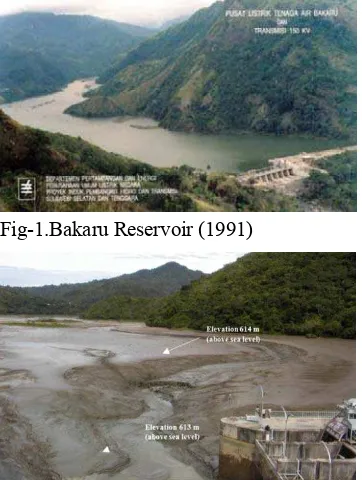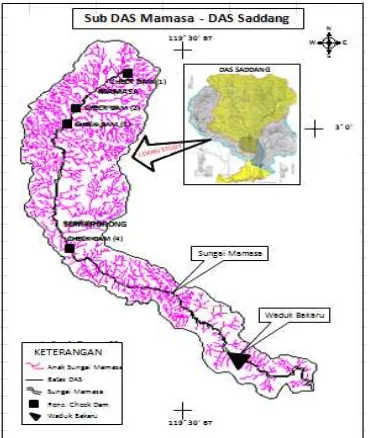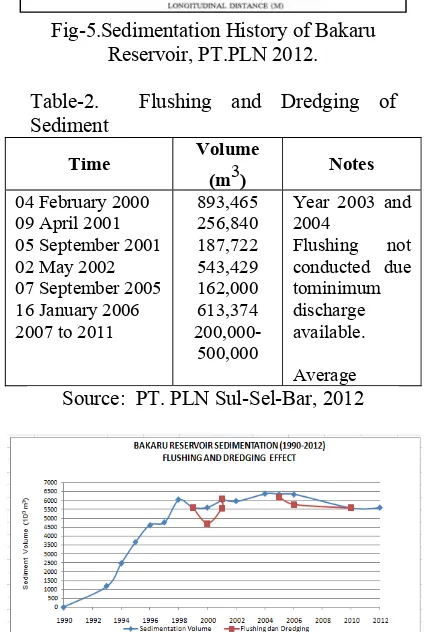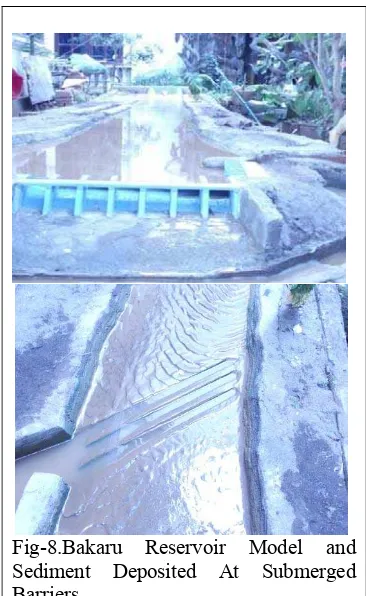S-104
SUBMERGE BARRIER
AS A SEDIMENT TRAP IN A RESERVOIR
Muchlish Amat1
Muh.SalehPallu2, Ahmad Munir2, MuchsanP.Hatta2
1Doctorate Program, Ciivil Engineering, Hasanuddin University email: [email protected]
2Post Graduate School of Engineering, Hasnuddin University, Makassar, Indonesia.
ABSTRACT
Sediment deposition and accumulation through the reservoir bed causes problems in the
shortage and utilization of surface water as well as subsequent decline of reservoir economic
and useful lifetime. The economic life time of a reservoir is defined as the time necessary for
aproximately 100% of the initial dead storsge capacity to be filled with incoming sediment.
While useful lifetime may be defined as the period in which a reservoir is still functioning even
beyond the economic lifetime. Sediment barrier placed at reservoir bed affect the inflow
pattern and, thus, intensify the increase of volume of sediment trapped before the sediment
flow reach the reservoir dead storage. The purpose of this study is to investigate the effect of a
submerge barrier on sediment deposition at the reservoir bed. The case study is Bakaru
Reservoir located in Mamasa River, South Sulawesi, Indonesia. For this purpose, an
experiment was carried out in Bakaru reservoir model with highly sedimented inflow “with”
and “without” submerged sediment barrier. The model considers the factors affecting the
reservor sedimentation and trap efficiency. The amount of sediment retained in the submerged
barrier as the results of sedimentation was measured and compared with that retained without
submerged barrier. The results obtained revealed that the submerged barrier improved the
volume of sediment retained and thereby improve the reservoir trap effeciency. Since the
sediment retained located outside and upstream of the dead storage, the sediment is easily
dregged out without interfering the reservoir operation, thus, will increase the economic and
theservice life of Dams.
1.
INTRODUCTION
Bakaru Dam is a vital infrastructure for
South Sulawesi, socially and economically.
The main purpose of the dam is to
preserve water for hydropower generation.
It was constructed to utilize the Mamasa
river flow throught the year with a daily
pondage reservoir. The original storage
capacity was 6.90 million m3 including 2
million m3 effective storage. The main
function of the reservoir is a hydropower
generation which was planned in two
stages.The first stage was completed in
1990 with 2x63 MW installed capacity.
The daily pondage was designed to
accommodate the effective storage capacity
to securely supply water during peak time
of 6 hour a day for four generating units
(stage I and stage II). The dam is located
on Mamasa River, South Sulawesi,
Indonesia.
The study area is characterized by tropical
moonson climate, with an average annual
temperature of 25.5
C and precipitation of
2,300 mm. The Mamasa River has a
nturaldarainage area of 1080 km2 and a
total length of 126 Km, originating from
the North of Mt. Paraleang at Polmas,
passing through Pinrang, and joins the
Sadang River at Temban, Enrekang. The
Mamasa riverbed slopes are; 1:120 for
upstream section, and 1:1400 for the
downstream of the Bakaru Dam
respectively.
Bakaru dam, which was constructed during
the period of 1989 – 1990, is a concrete
gravity dam with four spillways, two sand
drains, and two control gates. The dam and
the power plant are in good condition. The
power plant has been operated since
then with an average power production of
990 GWh per annum. Dead storage
capacity 4,900,000 m3, effective storage
capacity 2,000,000 m3, and gross storage
capacity 6,900,000 m3.Low Water Level
(LWL) EL. 612 m and Normal water Level
(NWL) EL. 615 m.The reservoir however,
has been subjected to severe sedimentation
making the situation crucial for the
implementation of Bakaru Stage-II. The
original sediment rate estimate was 133,000
m3/year. In fact, bathimetric survey in
1996 found the sediment accumulated
amount to 6.20 million m3, thus, the
effective storage left only aout 700,000 m3.
Furthermore, the sedimentation causes
deterioration of the metal equipment such
as guide van, runner, penstock, and the
cooling system components.
Fig-1.Bakaru Reservoir (1991)
Fig-2. Sediment Accumulation (2008)
Today, average annual sediment inflow is
about 700 to 800 thousand m3. This makes
severe reduction the reservoir storage
capacity.
Table-1. The current condition of the
System
Description Unit Original
Design ConditioCurrent n − Reservoir
capacity − Annual sedimentation − Effective reservoir − High water level
− Low water level
M3 M3/year m3 m m GWh/ye a
MW
6.92 x 106 0.13 x 106 2.00 x 106 615.50 612.00 999
2 x 63 2 x 63
0.8 x 106 0.75 0.70 x 106 615.50 613.00 850
− Energy production − Installed capacity o Stage I o Stage II
MW impleme
nted yet
Source: CompletionReport Bakaru2nd Stage, PLN.
Flushing and dredging have been performed
since year 2000 but little change to the
sediment accumulated infront of the dam.
The excess sediment inflow into Bakaru
Reservoir has been deteriorating the dam
functions for hydropower generation of
126 MW. The table below shows the
current condition of the system.
Fig-3.Reservoir Capacity Reduction
(MS.SofanHadi, 2011)
The main objective of the study is to find
the effect of submerged barriers on
sediment distribution along the Bakaru
reservoir bed and to look for effective and
economical measures for reservoir sediment
reduction and removal.In order to secure
the dam functions, both structural measures
and proper sediment management measures
are required.
2.
BAKARU RESERVOIR
SEDIMENTATION
General.
Globally, most of reservoirs, have been
affected by sedimentation. Some of them
are filled very seriously affected (CT.Yang,
2000). The overall annual loss rate of
reservoir storage capacity due to
sedimentation is estimated as 1 to 2 percent
of the total storage capacity (Yoon, 1992;
Yang, 2003). As for Bakaru Reservoir
case, the sedimentation becomes a serious
problem as it decreases the storage capacity
and, hence, makes the structure less
efficient and delay of the second stage plan
of 2x63 MW.
In the Mamasa Sub-Catchment , runoff
caused by rainstorm mainly occurs in rainy
season, from April to September, therefore,
the sediment is mainly concentrated in
flood season. Sediment in the Mamasa river
is originating from the upper reaches with
large quantities of eroded soil. This stems
from frequently alternating drought-rainy
seasons. These are resulting in loosening of
the soil surface thus facilitating and
accelerating water erosion.
Fig-4.Mamasa Sub-Catchment
Therefore, it leads to land degradation in
the upper reaches, sedimentation in lower
reaches and loss of reservoir's capacities,
abrasion of turbine and other components
of hydropower mechanical componenent
such as cooling system. On the other hand,
sediment results from soil erosion due to
deforestation, human activities, and
land-use mismanagement.
Bakaru reservoir sedimentation is the
process of sediment deposition formed after
the dam construction in 1990. The dam
caused the flow water impoundment, flow
velocity reduction, turbulence, and
consequently the settling process of
sediment carried by the Bakaru river
inflows. Measurement of the sedimentation
in the reservoir were carried out by PT.PLN
starting from 1994 to date except in 1998,
2003, and 2004 due to the less of inflow.
The sedimentation history of the reservoir
is shown in figure below.
Fig-5.Sedimentation History of Bakaru
Reservoir, PT.PLN 2012.
Table-2. Flushing and Dredging of
Sediment
Time Volume
(m3) Notes 04 February 2000
09 April 2001 05 September 2001 02 May 2002 07 September 2005 16 January 2006 2007 to 2011
893,465 256,840 187,722 543,429 162,000 613,374 200,000-500,000
Year 2003 and 2004
Flushing not conducted due tominimum discharge available.
Average
Source: PT. PLN Sul-Sel-Bar, 2012
Fig-6. Flushing and Dredging Effect
As the useful life of a reservoir directly
depends on the reservoir sedimentation
accumulation and reservoir economic
lifetime becomes the vital target of all
reservoir development make the issue as an
important subject within reservoir planning
and design as well as reservoir operation
and maintenance. On the aspect of
sediment control practice, the lost storage
volume due to sedimentation can be
recovered by use of the sediment-removal
methods such as: sluicing; dredging by
mechanical means; jetting with high
velocity jets; draining the reservoir
completely and hauling the material by
trucks,
or
others
kind
of
transportation;(RANGA and RAJU, 1985).
Reservoir sedimentation can also be
significantly reduced by construction of
by-pass channel such as siphon and sluice to
divert flows with high sediment
concentration to the river downstream.
Siphoning can be an effective method for
removing sediment from a small reservoir.
However, blockage in the pipeline,
hydraulic head available, and pipe length
could limit the use of this method. Sluicing
of sediment may be an effective method to
discharge reservoir sediment if the low
level outlet works have sufficient capacities
and the reservoir is relatively narrow,
[YANG, 1996].
Theoritically, the useful life of a reservoir
can be preserved by minimizing sediment
deposit and maximizing sediment outflow
through the reservoir. This paper presents
the issue of Bakaru Reservoir sedimentation
with emphasis on introduction of submerge
barrier for sediment handling measure. This
paper introduce the use of submerge barrier
as a countermeasure for Bakaru Reservoir
sedimentation problem.
3.
OVERVIEW OF SEDIMENT
MANAGEMENT METHODS
Avalable Methods
The methods available for managing
sediment in reservoir can be grouped into
the following four categories:
b.
Minimize Deposition of Sediment
in Reservoir. This includes:
Sediment pass-through, Density
current venting, Sediment bypass,
Hydrosuction bypass.
c.
Remove Sediment From Reservoir.
This
includes:
Flushing,
Excavation,
Dredging,
Hydrosuctiondredging.
d.
Compensate
for
Sediment
Accumulation in Reservoir. This
includes:
Enlarge
dam,
Decommissioning of dam, and
Construct a new dam.
Submerge Sediment Barrier Method
As mentioned above, various methods can
be applied to solve, or at least, to reduce
reservoir
sedimentation
problems.
Excavated SubmergedBarrier is a measure
to reduce sediment load to a dead storage.
It is a sediment trapping method to be
introducedto sedimen management. The
barrier consist of excavated channels layed
a cross the reservoir bed. The lower end of
the barrier is connected to a sediment pool
outside the reservoir. The principal function
of the barrier is trapping sediment laden and
drain it to a temporary sediment pool. A
part of the sediment will accumulate in the
pool while the cleaner water flows back to
the reservoir.Figure-7 shows the barrier
layout.
Their purpose is to reduce the sediment
load to a maximum possible level to
maintain low sediment accumulation in the
the reservoir bed or in the dead storage. To
attain this goal, the barriers are designed to
allow trapped sediment to travel along the
channels and deposit at sediment pool.
Since the sediment accumulated in the pool
outside the reservoir it can be easily
removed by dredging or other simple
measures. The sediment will finally be
removed to disposal area.
Based on the above categories submerged
barrier method may be classified into either
minimize deposition of sediment or remove
sediment from the reservoir categories.
Fig-7.Submerge Barrier Layout
As for Bakaru reservoir sedimentation
problem, the submerge barrier method is
applied to Bakaru Reservoir model to test
how the barrier control the sediment inflow
and extend the useful life of the reservoir
and to help sustain the vital benefit from the
electric power generation produce by the
reservoir
4.
MATERIAL AND METHOD
This study is designed to simulate the
relationship between sediment inflow and
the sediment retained by submerge barrier
with use of Bakaru Reservoir model. To
attain the purposes, an effort was made to
collect existing background data pertaining
to the study area, BakaruReservoir,
andBakaruDam Site. Data Mining consists
of data collection, preparation, and
modeling. The major source of recent
bathymetry data was the 1996-2011 survey
of the River System by the State Electric
Company
(PLN)
and
Hasanuddin
University (UNHAS). Hydrologic and
Sediment data were obtained from
PLN.Daily flow basis data record are
available at Bakaru Dam Control Office.
influence the surface flow pattern. The
model of weir, outlet gate, and their parts
were
made
considering
common
designs.The similarity in shape, dimensions
and roughness of the material in the
prototype design were simplified.
5.
RESULTS, DISCUSSION, AND
CONCLUSION
Results
Bakaru reservoir has been developed in
undistorted model with a scale of n:150.
The model includes Mamasa river portion,
Bakaru Dam, intake gates, drain inlet gates,
and the submerge barrier. Preliminary tests
were conducted. The first run was to test
how sediment distributed along the
reservoir bed and the volume of sediment
trapped without submerge barrier.
Fig-8.Bakaru Reservoir Model and
Sediment Deposited At Submerged
Barriers
The second run was to test how the
submerge barrier affect the sediment
trapped. The two experiments showed
promising results. Figure-8 below show the
experiment results.
Observation obtained from the run-tests
showed that the effect of series submerged
sediment barriers on sediment trapping has
been very good. The test with submerged
barriers trapped about 10% more sediment
compared to the test without barriers.
Discussion
In the case of this experiment, the
effectifness of the submerged barrier is
defined as the ratio of the sediment trapped
before and after the set up of the barriers.
Since the results showed an increase on
sediment trapped after the set up of the
barriers, it can be expected that the series
submerged barriers decresed the inflow
velocity and hence, increase the fall
velocity of the sediment particles.
Accordingly, more sediment deposited at
the barriers area compared with that have
accumulated before the set up of the
barriers.
In summary, the submerged barriers affect
the inflow pattern and the sediment
deposition on the reservoir bed by trapping
more sediment and, hence, reduce sediment
inflow to the dead storage. Therefore, there
is potential measurement to remove the
sediment from reservoir without interfering
the reservoir operations. Accordingly, it
may be expected that the sediment removal
will be inexpensive and economic and
useful lifetimeof reservoir will be
increased.
In order to optimize the barrier performance
and to trap as much sediment as possible,
more tests are required to evaluate the
sediment inflow characteristic and its
parameters, the sizes, numbers, and
dimensions of the barriers, as well as the
best fitted location for the barriers system
plan. This may significantly improve the
system adequacy.
Preliminary Conclusions`
a.
The series of submerged sediment
barriers increased the volume of
sediment trapped.
b.
The sediment trapped accumulated
at the barriers and, therefore, the
volume of sediment deposited in
the dead storage has been less.
c.
Since the sediment deposit
accumulated at temporary sediment
pool outside the reservoir, the
removal of the sediment would be
simple and economical.
Aknowledgement
The authors kindly thank the Head of Post
Graduate Program, the Head of Civil
Engineering
Department
Hasanuddin
University, Faculty of Engineering for their
strong support and coordination that made
this research continuesly in progres up to
this end.
6.
REFERENCES
Hadi,
MS
Sofan,
2012.
PenanggulanganSedimentasiW
aduk PLTA Bakaru,.
Prosiding
Seminar KomiteNasional Indonesia
UntukBendunganBesar
(KNIBB),
Jakarta.
Hadiharyanto, S.
KajianLajuErosi DAS
WadukBanyukuwung
Hassazadeh,Y.Predicting the Pattern of
Sediment in a Storage Reservoir, 1
stInternational
Conference
on
Managing Rivers in the 21
stCentury:
Issues & Challenges.
Ilyas, M.Arief, dkk, 1992,
Monitoring
danEvaluasiSedimentasi di DPS
Cimanuk Dan
PerkiraanDistribusiSedimentasiPada
RencanaWadukJatigede
,
PusatPenelitian
Dan
PengembanganPengairan.
Ilyas,
M.Arief,
dkk.
1999,
KajiUlangdanidentifikasiKondisiSedi
mentasiWaduk-waduk Di P. Jawa
,
Dep. PU PusatPenelitian Dan
PengembanganPengairan.
INACOLD-KomisiNasional
Indonesia
UntukBendunganBesar,
Seminar
Tahunan, Sanur, Bali, Mei 2011.
Loebis Joesran, 1993,
Hidrologi Sungai
,
YayasanBadanpenerbitPekerjaanUmu
m, Jakarta.
Markusic, M,
Effect Of Design Change
On Sediment Retention Basin
MashriquiH.Shahid, 2003.
Hydrodynamic
and sediment Transport Modelling of
Delataic Sediment
Processes.PhD.Dissertation
,
Department
of
Civl
and
Environmental
Engineering,
Lousiana State University.
Nurfaridah S, Munir A, 2011,
Pengelolaan DAS
BerbasisPenggunaanLahanDenganM
etode Fuzzy Multi-Attribute Decision
Making, StudiKasus DAS Mamasa
Sulawesi
, Prosiding Seminar Perteta.
Shahin M.M.A, 1993,
An overview of
Reservoir Sedimentation in Some
African River basins, Proceeding of
the Yokohama Symposium
, IAHS
Publ.no.217,1993.
Sloff, J.C. 1997 :
Modelling reservoir
sedimentation processes for sediment
management studies,Proceeding
conference “Hydropower into the
next century
”.
Susilo,
Edy.
KajianEfisiensiTangkapanSedim
enBeberapaWaduk di P.Jawa
Wahid,
Abdul.
Model
PerkembanganLajuSedimentasi di
WadukBakaruAkibatErosi Yang
Terjadi Di Hulu Sub-DAS
MamasaProvinsi Sulawesi
Selatan
.SMARTek.




